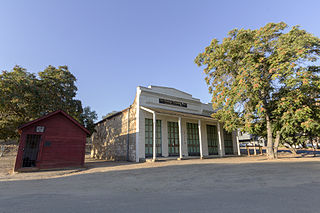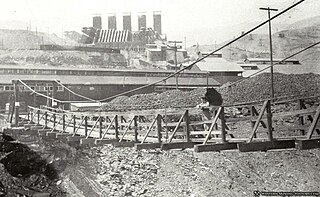| La Grange Mine | |
|---|---|
| Location | Trinity County, California; Along California State Route 299, about 4 miles (6.4 km) west of Weaverville, California |
| Founded | 1862 |
| Demolished | 1918 (closed) |
| Designated | 1962 [1] |
| Reference no. | 778 |
The La Grange Mine is a former mine located in Trinity County, California. At one time it was the largest hydraulic mine in California. Started operating in 1862, over 3,500,000 dollars of gold was extracted before it was closed down in 1918 due to rising costs of labor and steel after World War I. The quality of gold was low so hydraulic mining was used to take it from the ground. The site is now a California Historical Landmark. [1] [2] [3]

Trinity County is a county in the northwestern part of the state of California. As of the 2010 census, the population was 13,786, making it the fourth least-populous county in California. The county seat and largest community is Weaverville.

California is a state in the Pacific Region of the United States. With 39.6 million residents, California is the most populous U.S. state and the third-largest by area. The state capital is Sacramento. The Greater Los Angeles Area and the San Francisco Bay Area are the nation's second and fifth most populous urban regions, with 18.7 million and 9.7 million residents respectively. Los Angeles is California's most populous city, and the country's second most populous, after New York City. California also has the nation's most populous county, Los Angeles County, and its largest county by area, San Bernardino County. The City and County of San Francisco is both the country's second-most densely populated major city after New York City and the fifth-most densely populated county, behind only four of the five New York City boroughs.

World War I, also known as the First World War or the Great War, was a global war originating in Europe that lasted from 28 July 1914 to 11 November 1918. Contemporaneously described as "the war to end all wars", it led to the mobilisation of more than 70 million military personnel, including 60 million Europeans, making it one of the largest wars in history. It is also one of the deadliest conflicts in history, with an estimated nine million combatants and seven million civilian deaths as a direct result of the war, while resulting genocides and the 1918 influenza pandemic caused another 50 to 100 million deaths worldwide.
Contents
The name comes from the owner who bought it in 1893, the French baron Ernest de la Grange. He came from North of France with his wife (Clémentine de Chaumont Quitry) and his two children (Emilie and Amaury de la Grange)
Coordinates: 40°44′28″N122°59′26″W / 40.74111°N 122.99056°W [4]

A geographic coordinate system is a coordinate system that enables every location on Earth to be specified by a set of numbers, letters or symbols. The coordinates are often chosen such that one of the numbers represents a vertical position and two or three of the numbers represent a horizontal position; alternatively, a geographic position may be expressed in a combined three-dimensional Cartesian vector. A common choice of coordinates is latitude, longitude and elevation. To specify a location on a plane requires a map projection.










